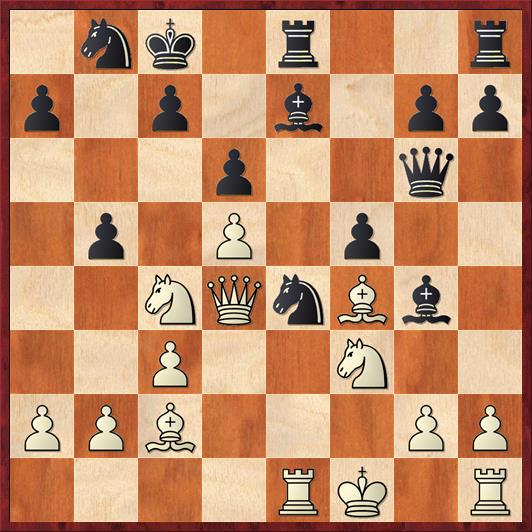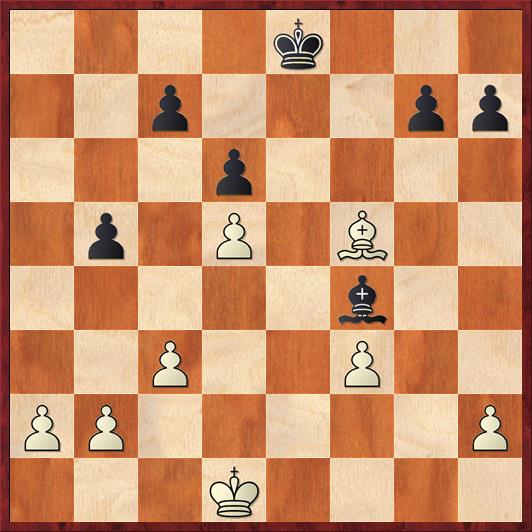Two posts in one weekend! Just for fun, here is another game between me and my computer. It’s a King’s Gambit that goes a little bit haywire, but most unexpectedly goes all the way down to an opposite color bishops endgame.
I find it fairly hard to beat the computer with the King’s Gambit. It is immune to psychological pressures and very good at hard-nosed, practical defense — either holding the pawn or letting me win the pawn back just in time to watch my position collapse.
This game was no exception. It kicked my butt in the opening, but I had set its rating at 2105 and that means occasionally it makes mistakes. It picked move 17 to make a particularly stunning — but fascinating — mistake, and that is when the party gets started!
Dana — Shredder
1. e4 e5 2. f4 ef 3. Bc4 d6 4. d4 Qh4+ 5. Kf1 Be6
And just like that, we’re in a position I’ve never seen before. That’s the amazing thing about computers: even in an opening you know fairly well, their book is bigger.
6. Bb3?! …
Now we are not only in a position I’ve never seen before — we’re in one that no human has ever seen before! No previous games on ChessBase. More customary for White in this rare variation is 6. Qd3. I have to say, Black’s variation has a lot of practical value. I might try it myself if I ever should face the Bishop’s Gambit as Black. (It’s only happened once in my chess career.)
6. … Nc6?! 7. Nf3 Bg4 8. c3 …
White had pretty easy equality with either 7. d5 or 8. Nxh4, but I wanted to play in more ambitious King’s Gambit style. Maybe not a good idea against the computer.
8. … Qf6 9. Qe2 O-O-O 10. Nbd2 Qg6 11. Bc2 Nf6 12. Nc4 Re8 13. Bxf4 Nxe4 14. d5 Nb8 15. Re1 f5 16. Qd3 Be7 17. Qd4 b5?
Position after 17. … b5. White to move.
FEN: 1nk1r2r/p1p1b1pp/3p2q1/1p1P1p2/2NQnBb1/2P2N2/PPB3PP/4RK1R w – – 0 18
I’ve commented before on Shredder’s extremely pugnacious style, but this is unbelievable even for Shredder. After the simple 17. … Nc5 I really don’t know where White’s compensation is for the pawn. But now it’s as if Shredder is waving a red flag at me: Come and get me, if you dare!
I wrote in my previous entry about the importance of regrouping and looking at the position with fresh eyes when something truly unexpected happens. Here I regrouped by taking my time-out and studying the position on a board.
The moves I instinctively looked at first were 18. Qxa7, sacrificing a piece, and 18. Na5, moving menacingly toward the black king. In a blitz game or even a tournament game, I would have found it very hard to refrain from playing those moves. The King’s Gambiteer sniffs blood!
And yet reflecting calmly on the position, I came to the conclusion that both moves were wrong. After 18. Qxa7 bc, White has two ways to continue the attack. After 19. Ba4, I realized that Black has the very important interpolation 19. … Bxf3!, removing a valuable attacker. After this move, white’s remaining attackers are not strong enough to justify a piece sac. White can try to anticipate Black’s anticipation with 19. Nd4, but this too seemed to fall short after 19. … Bh4!, when suddenly Black’s threats on the kingside are just as nasty as White’s threats on the queenside.
Likewise, 18. Na5 just seemed to park the knight in a fairly useless location after 18. … Nc5. White can try 19. Qb4 a6 20. a4, but it looks as if Black’s attack scores first after 20. … Bxf3.
Reluctantly, almost petulantly, I started looking at 18. Ne3 — a move I would never have considered at first, because it seems to be allowing Black to “get away with” his impudent move 17. … b5 and retreating from the battle. But in fact, 18. Ne3 has a number of virtues. Most importantly, it is White’s only move that anticipates Black’s intention to capture on f3. In fact, I thought that Black simply couldn’t play 18. … Bxf3 19. gf, because the knight on e4 is pinned — if it moves, then 20. Bxf5+ will win the queen. On the other hand, if Black plays routine defense (e.g., 18. … Nc5 or 18. … Kb7), then 19. Nxg4! is quite good. It prevents … Bf6 for one more move, and forces Black to take on g4 with his queen instead of with the f-pawn.
The morals of this story are: sometimes “retreating” moves are actually good attacking moves; it’s always helpful to think about what your opponent wants to do; and even in a King’s Gambit, you need to think with your brain and not with your emotions.
Let’s fast forward now to the next turning point.
18. … Bxf3 (anyway!) 19. gf Bf6 20. Qxa7 Nd2+ (I missed this, but fortunately it’s not that strong) 21. Ke2? (better was 21. Kf2) Nc4 22. Kd1 Nxe3+ 23. Rxe3 Be5.
Position after 23. … Be5. White to move.
FEN: 1nk1r2r/Q1p3pp/3p2q1/1p1Pbp2/5B2/2P1RP2/PPB4P/3K3R w – – 0 24
I wasn’t too keen on the idea of 24. Bxe5 de, which would give Black a strong central pawn duo and would enable his queen to come to the defense of his queenside. Does White have any better options?
(Space inserted if you want to think about it.)
Here I played my second-favorite move of the game (this time without the benefit of a time-out), 24. R1e1! It’s particularly beautiful, and ironic, that my invasion with the queen on a7 eventually does pay dividends — not by giving me a mating attack, but by enabling me to trade down to a won endgame.
24. … Bxf4
I suppose Black could try 24. … Qf6, but then his forces are completely paralyzed and I can start breaking down his weakened queenside with 25. a4.
25. Rxe8+ Rxe8 26. Rxe8+ Qxe8 27. Bxf5+ Kd8 28. Qxb8+ Ke7 29. Qxe8+! …
This is better than 29. Qxc7+, which wins a pawn but leaves queens on the board and therefore gives Black counter-chances.
29. … Kxe8
Position after 29. … Kxe8. White to move.
FEN: 4k3/2p3pp/3p4/1p1P1B2/5b2/2P2P2/PP5P/3K4 w – – 0 30
The smoke has cleared, and in spite of the bishops of opposite colors, White is winning (or very close to it).
30. Bxh7 …
The point is that Black still cannot defend the b5 pawn. If 30. … Kd7 31. Bf5+! chases the king away first and then 32. Bd3 wins the pawn. If the pawn were on b6, the game would be a dead draw.
I like the way that Black is finally “punished” for his overzealous move 17. … b5 fourteen moves later. The statute of limitations never runs out on pawn weaknesses!
I’ll give the rest of the game with minimal annotations; I don’t think that Black has any major improvements.
30. … Ke7 31. Bd3 b4 32. cb Bxh2 33. Kc2 Kf6 34. Kc3 Be5+ 35. Kc4! …
The b2 pawn is meaningless.
35. … Bxb2 36. a4 Ke5 37. a5 Bc1 38. Kb5! …
Black cannot defend the c7-pawn, and the two connected passers will decide the game.
38. … Kxd5 39. Be4+ Ke5 40. Kc6 Bd2 41. a6 Be3 42. Kxc7 d5 43. Bg6 and Black resigned six moves later.






{ 1 comment… read it below or add one }
I might have”improvised” with 24. Re5, clearing the a7-g1 diagonal so White can follow up with 25 Rg1. The Black queen looks overloaded, having to guard both f5 and g7.